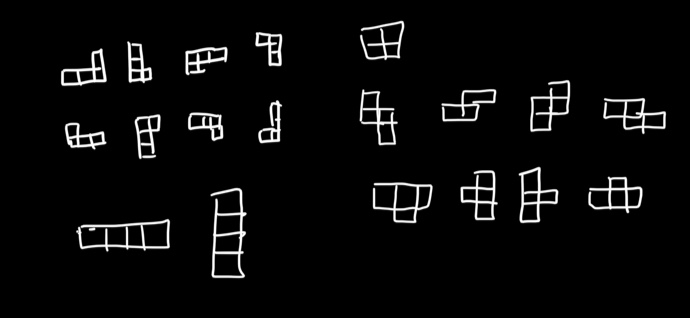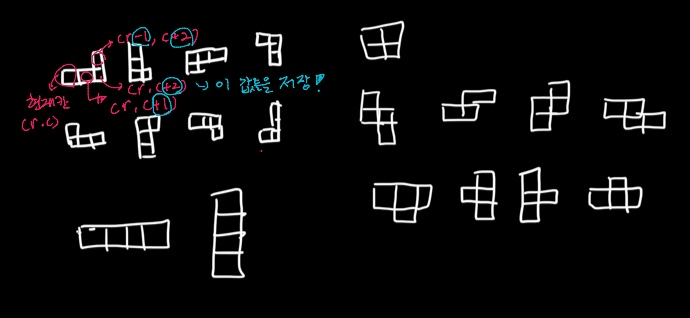[백준] 14500번 테트로미노
정사각형 4개를 이어 붙인 폴리오미노 → 테트로미노
-
문제에서 , 이러한 테트로미노에 어떤 종류가 있는지 알려준다.
-
N x M 인 종이 위에 테트로미노 하나를 놓으려 한다.
-
종이의 각 칸에는 "정수"가 하나 쓰여 있다.
-
테트로미노 하나를 적절히 놓아, 테트로미노가 놓인 칸에 쓰여있는 수들의 합을 최대로 하는 프로그램을 작성하라.
-
테트로미노는 [ 회전, 대칭 ] 을 시켜도 된다.
풀이생각
(44분)
- 가장 먼저드는 생각은 문제에서 주어진 도형들을 , 대칭, 회전 시킨 경우에 대한 자료를 먼저 다 만들어두고
- 5가지 테트로미노 이지만
- 회전, 대칭의 경우를 만들면
- 10개가 넘는 경우가 나올 것임
- 완전탐색을 하는 것이다.
- 즉, 각각의 경우에 대해, 모든 칸에서 해당 도형을 움직이며 합을 구한다.
- 그런데 N(세로) x M(가로) 는 최대 500까지
- 어떤 칸을, 도형의 시작칸이라고 가정하였을 때
- 500 x 500 x (약 20가지 경우) x 4(네 칸) 의 복잡도가 나오기에
- 완전탐색을 하더라도 괜찮을 것 같다.
- 즉 이 문제는 완전탐색으로 풀어야 하는 듯 하다.
자 이제 경우의 수를 만들어 보자
현재칸으로부터 이동할 칸에 대한, x,y값을 저장한 경우들을 cases라는 배열에 저장했다.


import java.io.BufferedReader;
import java.io.IOException;
import java.io.InputStreamReader;
import java.util.*;
public class Main {
public static int[][][] cases
= new int[][][]{ {{0,1},{0,2},{-1,2}},{{1,0},{2,0},{2,1}},{{1,0},{0,1},{0,2}},{{0,1},{1,1},{2,1}}
,{{1,0},{1,1},{1,2}},{{0,1},{1,0},{2,0}},{{0,1},{0,2},{1,2}},{{0,1},{-1,1},{-2,1}}
,{{0,1},{0,2},{0,3}},{{1,0},{2,0},{3,0}}
,{{0,1},{1,0},{1,1}}
,{{1,0},{1,1},{2,1}},{{0,1},{-1,1},{-1,2}},{{1,0},{0,1},{-1,1}},{{0,1},{1,1},{1,2}}
,{{0,1},{0,2},{1,1}},{{0,1},{-1,1},{1,1}},{{1,0},{-1,0},{0,1}}
,{{0,1},{0,2},{-1,1}}
};
public static int n,m;
public static int max =0;
public static BufferedReader br = new BufferedReader(new InputStreamReader(System.in));
public static StringTokenizer st;
public static int[][] arr = new int[500][500];
public static void setting()throws IOException {
st = new StringTokenizer(br.readLine());
n = Integer.parseInt(st.nextToken());
m = Integer.parseInt(st.nextToken());
for(int i=0;i<n;i++) {
st = new StringTokenizer(br.readLine());
for(int j=0;j<m;j++) arr[i][j] = Integer.parseInt(st.nextToken());
}
}
public static void solve(){
int cnt=0;
int x=0,y=0;
boolean fail = false;
for(int r=0;r<n;r++){
for(int c=0;c<m;c++){
//[r,c] 를 첫 시작점이라고 생각한다.
// casese들을 돌아가며, 해당 테트로노미를 시작 칸을 [r,c]라고 한다.
for(int tet=0;tet<cases.length;tet++){
cnt=0;
fail = false;
cnt+=arr[r][c];
// 테트로노미가 될 각 칸의 위치를 이용하여 각 칸의 값을 얻어온다
for(int dir=0;dir<cases[tet].length;dir++){
y = r +cases[tet][dir][0];
x = c +cases[tet][dir][1];
// 테트로미노가 될 수 없는 경우라면 이 tet은 pass하기위해 boolean사용
if(y<0 || y>=n||x<0||x>=m) {
fail = true;
break;
}
cnt+=arr[y][x];
}
if(fail)continue;
// 모든 칸을 돌았다면
max = Math.max(max,cnt);
}
}
}
}
public static void main(String[] args)throws IOException {
setting();
solve();
System.out.println(max);
}
}
